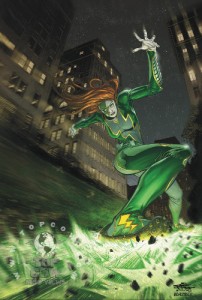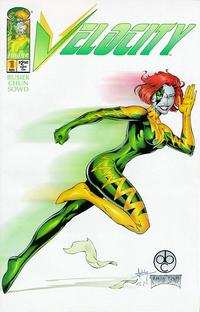 Just last week, I read and reviewed the 1996 Velocity miniseries, and re-read her 2007 Pilot Season one-shot. As you may recall, the book was one of that year’s winners, so Top Cow began preparing a new series around the character. It was originally announced for November 2008, then pushed back, and eventually canceled.
Just last week, I read and reviewed the 1996 Velocity miniseries, and re-read her 2007 Pilot Season one-shot. As you may recall, the book was one of that year’s winners, so Top Cow began preparing a new series around the character. It was originally announced for November 2008, then pushed back, and eventually canceled.
Details of the breakdown have been hazy. Artist ChrisCross left first, citing creative differences. Writer Joe Casey said the book had been lost in a shuffle of editorial firings. Now publisher Filip Sablik tells Top Cow’s side as one element in an interview about the recently-announced third round of Pilot Season:
This series is unfortunately “missing in action”. We started working on the series with the original Pilot Season writer Joe Casey with the best of intentions. We couldn’t secure original artist Kevin Maguire so we brought in ChrisCross, who was Joe’s top choice for artists and Snakebite on colors. We actually had the first entire issue complete and a script in for the second issue along with some art in progress when we ran into a disagreement in how the first story arc should proceed. Joe had a direction he wanted to go in, which we didn’t agree with and truthfully wasn’t something we felt represented Velocity (as a company owned character) [emphasis added] in the best way. We tried to work it out with Joe, but reached an impasse and everyone decided it was best if Joe walked away from the series. It’s a damn shame too, because as any publisher can tell you it’s never an easy financial decision to have an entire issue plus completed and not be able to put it out. At the end of the day though, we can’t afford to put out a comic we’re not completely happy with. We’re still looking into how best to retool Velocity and hope to be able to update the fans in the near future. Again Velocity is going to play a vital role in this summer’s Cyberforce/Hunter-Killer series and I hope she’s a character we get to revist on a solo basis in the future.
Now, obviously, everyone involved is going to want to minimize their own share of the blame, but it does seem to come down to this:
The writer and company wanted to do different things with the character, and the company won.
At first glance, it’s kind of ironic considering that Top Cow is one of the original Image studios, and was founded by artists who were tired of being told what they could and couldn’t do with the characters they worked on.
On the other hand, Cyberforce creator Mark Silvestri is still the CEO of the company. So to the extent that he shapes company policy, it’s still a matter of the character’s creator asserting control. For now, anyway. If he ever leaves Top Cow, they’ll be in a similar situation to Marvel without Stan Lee.
It does make me wonder how things will play out with all the various creator-owned characters in the long run. 70 years from now, will someone be licensing, say, The Savage Dragon from Eric Larsen’s estate the way DC is doing The Spirit?
I’m also really curious as to what Joe Casey had in mind that Top Cow didn’t want to do.

